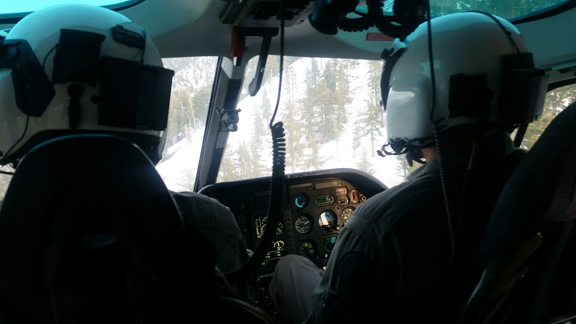
The San Bernardino County Sheriff’s Aviation Unit, with an MSAR member, flies over a portion of Cucamonga Peak Trail where two missing hikers were last seen.
By Mary O’KEEFE
The weather is getting warmer, flowers are in bloom and the rain seems to be taking a Southern California break. This means many things to many people and to some it means, “Let’s go on a hike in the Angeles National Forest.”
Unfortunately some who take that trip up to the trails in ANF forget how unforgiving nature can be, something members of the Montrose Search and Rescue team never forget. With the warmer, dryer weather, MSAR has been busy.
“We get a lot of people who go off trail,” said Janet Henderson, MSAR team leader.
Hikers may plan to follow one trail then, once they are in the forest, see another area that looks like a trail. If they follow it, they may find themselves in more rugged terrain.
Knowing the area, and its trails, is important. Henderson said some hikers will see a trail described online and decide to take it without doing sufficient research.
“Plan a route, let someone know and don’t change it,” she said.
There are examples of people of varying levels of hiking skill going off the trail they planned to hike and getting lost. Sharing a hiking plan with others is important if, and when, hikers find themselves lost or injured.
“Some people will even leave their plan in their car,” Henderson said.
This is of great advantage for searchers if something goes wrong.
“We had an incident a month ago when two hikers in a group had slipped near Mt. Waterman and had [injured themselves],” said Sgt. John Gilbert, Los Angeles County Sheriff’s Dept./Crescenta Valley Station and MSAR coordinator.
The hikers’ location was found in part because they had a personal locator beacon. These type of beacons are satellite-powered electronics that will send a message automatically. These devices have become popular for outdoor enthusiasts. If hikers find themselves lost or injured they activate their PLB which sends out an SOS that includes their exact location.
Gilbert said he has seen how useful these devices can be but reminds people that when they activate the PLB it takes some time to get the message to those rescuers closest to the hiker. “It takes about 40 minutes,” Gilbert said.
The signal goes to several locations, from national to state to individual stations; however, it does pinpoint the exact location of the person in need.
Gilbert added one of the easiest things to do before going on a hike is to plan for that hike.
“Research where you are going,” he said. “Don’t hike alone and don’t get separated from your group. When hiking the more the merrier is better.”
Another bit of advice from both Henderson and Gilbert is for hikers to make sure they take enough water with them and are aware of weather conditions.
“In the flat land it may be 80 degrees [Fahrenheit]. You may see the snow at the top of a mountain and think it won’t affect you,” Gilbert said.
But, he added, often people either plan to be down off the trails by sunset or they get injured or lost and then find themselves in the forest – which can become very cold after the sun sets. And snow and ice can be an issue not only after sunset but in the shade during the day.
“Conditions change rapidly,” he said.
MSAR members are trained by LASD and are reserve deputies and civilian volunteers. They patrol the ANF on weekends, and are available on call 24/7. However, they also travel beyond the area to assist other search and rescues teams. MSAR has been assisting in the search for two missing hikers in the Mt. Baldy area. San Bernardino County Sheriff’s asked for mutual aid assistance. MSAR joined search and rescue crews from San Diego, Orange County and Riverside, Gilbert said.
Gilbert joined MSAR team members on Tuesday to head up to Mt. Baldy. The hikers, Eric Desplinter, 33, of Chino Hills, and Gabrielle Wallace, 31, of Rancho Cucamonga, were last seen on Saturday at 10 a.m. They were hiking up to Cucamonga Peak, about 8,800-foot elevation. When they did not return to friends by 7 p.m. on Saturday, friends reported them missing. As of press time, the search continues with no updates released.
“Our team had one of the hardest assignments,” Gilbert said. “The conditions were too windy for the helicopter to fly the [members] up.” If the weather conditions were better, the team would have been helicoptered to their assigned search area; instead they had to hike in.
“We started at 9 a.m. and the team was out there for 14 hours,” Gilbert said. “One of our team members [calculated] they hiked 14 miles in 14 hours in rugged terrain and in conditions that varied, with some areas that were extremely windy and some parts extremely icy.”
They began at about 5,000 feet and hiked up to about 7,500 feet, but the team did not find any sign of the hikers.
MSAR members are volunteers who get paid $1 a year. They are under the direction of LASD. For information on joining the team, call Dept. Martin at
(818) 236-4019
